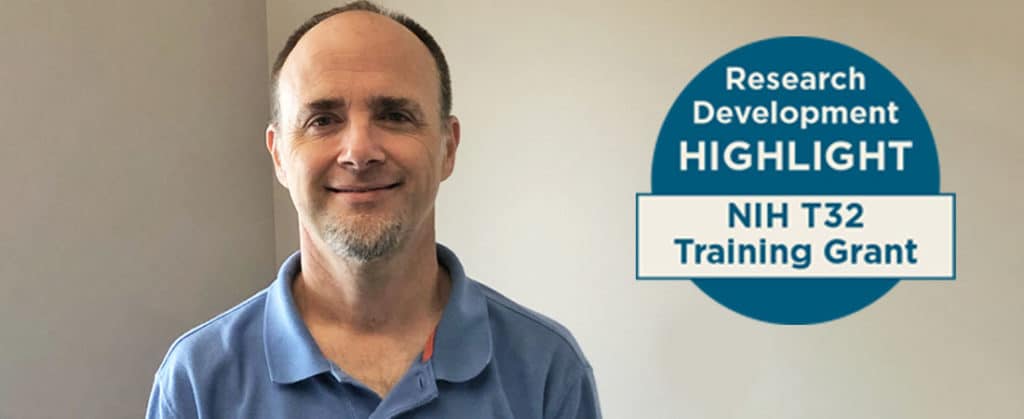Todd Reynolds recently received the coveted, “We’re pleased to inform you…” email, informing him that his proposal for a National Institute of Health’s prestigious T32 graduate student training grant was to be awarded.
Reynolds, professor of microbiology, led the Integrated Membrane Program (IMP) T32 Training Grant proposal effort to address a gap that exists in the biomedical workforce of the future: integrated training across multiple approaches and disciplines for studying biological membranes (biomembranes), which are crucial structures that define and separate physical spaces within and outside cells, making them fundamental to life on Earth.
Reynolds attributes this successful award to several factors. One was the active Community of Scholars for Biomembranes (CoS) that was sponsored by the Office of Research, Innovation, and Economic Development (ORIED). The second was the ability to manage a “gargantuan amount of data” required by NIH for these proposals. Finally, the intensive proposal development team from ORIED, the faculty with the CoS, and UT’s strong institutional support were all crucially important.
He says that multiple disciplines have applicability to biomembranes, and the IMP training program connects seven UT departments and four colleges: Biochemistry and Cellular and Molecular Biology, Biosystems Engineering and Soil Science, Chemical and Biomolecular Engineering, Chemistry, Microbiology, Nutrition, and Physics.
“Increasingly, we need scientists who can bridge these fields and integrate different approaches to meet the next generation of research challenges,” Reynolds says, noting that over the next five years, 25 graduate students will each be advised by two mentors from different disciplines.
“That’s the differentiator, the hook that Heidi suggested,” he explains, referring to Professor Heidi Goodrich-Blair, one of the T32 Steering Committee members and department head for UT’s Department of Microbiology.
“Traditionally, such graduate training is very siloed. We’re bringing people together to train students who will excel because they can speak to both disciplines coherently. Our integration is our differentiator,” he adds.
Reynolds says this was an extremely complicated proposal process, very different from the science proposals he usually submits. He celebrates the proposal support he received from ORIED and says that Jennifer Webster, interim research development (RD) director, provided extremely valuable writing and editing, project management, and data wrangling.
“In addition, she kept us on task,” he says, noting the final proposal was over 250 pages long. “Jennifer studied the RFA and made sure we addressed the needed items and filled in the missing parts. She helped us identify what NIH wanted and let us know when we didn’t explain our ideas well. It clearly made the difference!”
Webster says this T32 was the most difficult proposal she’s worked on in 12 years, primarily because of the strict NIH requirements related to data. She worked closely with Caroline Mann and Kent Wagoner, assistant directors within UT’s Office of Institutional Research and Assessment (OIRA), to create a series of data tables. Five years of numbers were required for students in each of the seven departments, broken down by applications, admissions, and matriculations, in addition to individual characteristics such as underrepresentation, disability, gender, and disadvantaged backgrounds.
“We would not have gotten this grant without good data,” Webster says, noting that the proposal included data provided by OIRA, ORE, the Graduate School, and individual faculty members.
Mann called the effort “difficult data wrangling,” but added that UT benefits from a matured data warehouse that provides a solid foundation, along with better coordination between OIRA and graduate school admissions.
“Within our data warehouse, we have access to a decade of data, and we can more easily provide data that might not have been possible five years ago,” Mann says.
Another area of coordination provided by Webster was institutional support. NIH requires that universities provide significant cost share to demonstrate a commitment to the T32 training program. She made the case to justify the cost share request and negotiated with department heads, the Graduate School, ORIED, and the Office of the Provost to secure approvals.
“To succeed with a T32, the university has to make a large commitment. Jennifer helped us craft that proposal and deal with the go/no-go decision. And UT came through!” Reynolds says.
Webster reminds faculty to ask for such resources when they’re needed. “Be audacious in budgeting for big ideas,” she suggests.
Finally, Reynolds says the T32 proposal success was made possible by UT’s Biomembranes Community of Scholars, which he helped establish in 2018, ably supported by Diana Moyer, RD manager.
“The reviewers mentioned our Community of Scholars many times. The program expects us to already have something in place, to expand something already set up,” Reynolds says, adding that he highly recommends a CoS to faculty who want to connect to others across disciplines.
“While this program is complex, I think other T32s could be a great idea. I’d love this to be the first of many. A CoS is a great place to start, to create the right environment. It brings people together in a formal manner, provides structure to become an actual entity. I’d be thrilled to share our experience, and I’m so grateful to ORIED for starting that level of support,” Reynolds says.
For more information on proposal support or starting a Community of Scholars, contact AVCRD@utk.edu.
